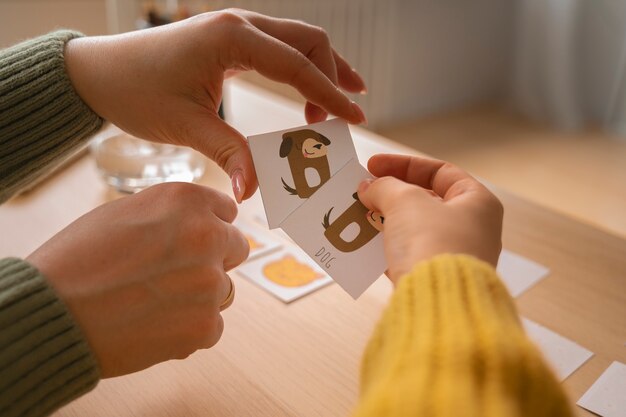How Flashcards Make Learning Fun and Engaging for Students of All Ages

Learning doesn’t have to be a dull or monotonous task. With the right tools and techniques, it can be engaging, interactive, and even fun. Flashcards are one such tool that can transform the way you approach studying. Whether you’re a student tackling a new subject, a professional trying to acquire a new skill, or a parent helping your child, flashcards make learning enjoyable while boosting retention and recall. In this article, we’ll explore why flashcards are a fun way to learn, the science behind their effectiveness, and how to maximize their potential to keep learning interesting.
Why Flashcards Make Learning Fun
Flashcards make learning engaging because they break down information into bite-sized chunks that are easy to digest. This method makes studying less overwhelming, allowing you to focus on one concept at a time. The quick and interactive nature of flashcards turns learning into a game, where you challenge yourself to recall information and test your memory.
Flashcards also introduce variety into study sessions. Instead of reading through dense textbooks or listening to long lectures, you get to quiz yourself, shuffle cards, and even involve friends or classmates for a competitive spin. The repetitive and interactive nature of flashcards helps maintain focus, while the flexibility to mix up the order or content keeps it from getting boring.
The Science Behind Flashcards
The effectiveness of flashcards lies in two key cognitive principles: active recall and spaced repetition. Both processes are critical for efficient learning and long-term memory retention.
- Active Recall: This is the process of actively retrieving information from memory. When you use flashcards, you are forced to think of the answer before flipping the card, engaging your brain in a more active form of learning. This helps strengthen neural connections, improving your ability to remember the information in the future.
- Spaced Repetition: This technique involves reviewing information at increasing intervals over time. Research shows that revisiting material just before you forget it solidifies knowledge in long-term memory. Flashcards are ideal for applying spaced repetition, whether manually with physical cards or through digital flashcard apps that automate the process.
How to Make Flashcards Fun
To keep learning fun with flashcards, creativity and customization are key. Here are some ways to spice up your flashcards and make your study sessions enjoyable:
- Color-Coding: Use different colors for categories or subjects. For example, you could use blue for vocabulary, green for grammar, and red for key dates. Colors can help break up the monotony and aid memory by creating visual associations.
- Add Visuals: Pictures, diagrams, and even emojis can make flashcards more engaging, especially for visual learners. For example, when learning languages, you could include an image of the object next to the word you’re trying to memorize.
- Gamify Your Learning: Turn studying into a game. Challenge yourself to go through your deck without getting a single answer wrong or time yourself to see how quickly you can complete a set. You can also compete with friends or family members to add a fun, competitive edge.
- Use Flashcards with Friends: Studying doesn’t have to be a solo activity. Use your flashcards in group study sessions or quiz each other. This adds a social element that can make learning more fun and less isolating.
Read also:Why Construction of Floors Is More Complicated
Digital Flashcards: An Engaging Way to Learn
Digital flashcards offer even more ways to make learning interactive and fun. Apps like Ankimobile website allow users to create custom flashcards, add multimedia elements like images and audio, and take advantage of spaced repetition algorithms. These digital tools enhance the learning experience and are perfect for students or professionals who are always on the go.
The Ankimobile website stands out for its flexibility and advanced features. With Anki, users can access pre-made flashcard decks or create their own, integrating images, videos, and sounds to make studying more dynamic. The app’s spaced repetition algorithm ensures that users review their cards at optimal intervals, maximizing retention. Whether you’re learning a language, studying for a medical exam, or preparing for a test, Anki makes the process smoother and more enjoyable.
Digital flashcards also offer the convenience of portability. With a mobile app, you can study anytime and anywhere—whether you’re commuting, waiting in line, or taking a break between tasks. This flexibility keeps learning continuous and easy to integrate into your daily routine, making it more enjoyable.
Using Flashcards for Different Subjects
Flashcards are versatile and can be used to learn virtually any subject. Here’s how they can be applied in different fields to make learning fun:
- Language Learning: Use flashcards to memorize essential vocabulary, common phrases, descriptive Spanish adjectives, and grammar rules. You can incorporate images for words and even add audio to practice pronunciation. Flashcards are especially useful for reviewing language content in short bursts throughout the day.
- Science and Medicine: Flashcards are effective for learning complex concepts, terminologies, and processes in fields like biology, chemistry, and anatomy. You can use diagrams and charts to visualize scientific information, making it easier to retain.
- History and Social Studies: For subjects involving dates, historical events, and significant figures, flashcards help in memorizing and understanding the relevance of each concept. You can also create thematic flashcards to group related information.
Best Practices for Using Flashcards
While flashcards are fun, using them correctly can make your learning even more efficient. Here are some best practices to get the most out of your flashcard sessions:
- Review Regularly: Consistency is key. Set aside a few minutes each day to review your flashcards. Short, frequent sessions are better for memory retention than long, infrequent sessions.
- Shuffle the Deck: Don’t study flashcards in the same order each time. Shuffling your cards forces your brain to focus on the content rather than relying on memorizing the sequence.
- Use Active Recall: Try to recall the information before flipping the card. Even if you’re unsure of the answer, making an effort to retrieve it helps strengthen your memory.
The Benefits of Flashcards for All Learners
Flashcards aren’t just for students—they can be beneficial for learners of all ages. Whether you’re a professional studying for certifications, a hobbyist picking up a new language, or a parent helping your child with schoolwork, flashcards can make learning an engaging and interactive experience.
- For Children: Flashcards are a great way to introduce young learners to new concepts in a fun and accessible way. Games, pictures, and interactive elements make studying enjoyable for children while reinforcing key learning objectives.
- For Adults: Flashcards are just as valuable for adult learners, whether for work, personal growth, or hobbies. Flashcards help break down complex information, making it easier to grasp and retain, regardless of the subject matter.
Conclusion
Flashcards are a versatile, effective, and fun tool for learning. They engage the brain through active recall and spaced repetition while offering endless opportunities for customization and creativity. Whether you’re using traditional paper flashcards or digital tools like the Ankimobile website, the key is to make your study sessions enjoyable and interactive. With flashcards, learning can become more than just a task—it can be a fun and rewarding experience that helps you retain more knowledge and feel more confident in your abilities.





